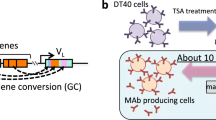Abstract
Early etiological diagnosis is very important for the control of sudden viral infections, and requires antibodies with both high sensitivity and high specificity. Traditional antibody preparation methods have limitations, such as a long and arduous cycle, complicated operation, and high expenses. A chicken lymphoma cell line, DT40, is known to produce IgM-type antibodies and undergo gene conversion and somatic mutation in the variable region of the immunoglobulin gene during culture. Here, the DT40 cell line was developed to produce antibody libraries and prepare antibody rapidly in vitro. Since hypermutation in DT40 cells was regulated by the activation-induced cytidine deaminase (AID) gene, AID expression needs to be controlled to either fix the Ig sequence by stopping mutation or improve affinity by resuming mutation after the antibodies have been selected. In this study, we generated a novel AID-inducible DT40 cell line (DT40-H7), in which the endogenous AID gene was knocked out using the CRISPR/Cas9 genome editing system, and an inducible AID gene, based on the Tet-Off expression system, was stably transfected. AID expression was controlled in DT40-H7 cells in a simple and efficient manner; gene conversion and point mutations were observed only when AID was expressed. Using the antibody library generated from this cell line, we successfully obtained monoclonal antibodies against the NS1 protein of Zika virus. The DT40-H7 cell line represents a useful tool for the selection and evolution of antibodies and may also be a powerful tool for the rapid selection and generation of diagnostic antibodies for emerging infectious diseases.




Similar content being viewed by others
References
Arakawa H, Hauschild J, Buerstedde JM (2002) Requirement of the activation-induced deaminase (AID) gene for immunoglobulin gene conversion. Science 295:1301–1306
Contreras D, Arumugaswami V (2016) Zika virus infectious cell culture system and the in vitro prophylactic effect of interferons. J Vis Exp 114:54767
Cumbers SJ, Williams GT, Davies SL, Grenfell RL, Takeda S, Batista FD, Sale JE, Neuberger MS (2002) Generation and iterative affinity maturation of antibodies in vitro using hypermutating B-cell lines. Nat Biotechnol 20:1129–1134
Gossen M, Bujard H (1992) Tight control of gene expression in mammalian cells by tetracycline-responsive promoters. Proc Natl Acad Sci U S A 89:5547–5551
Harris RS, Sale JE, Petersen-Mahrt SK, Neuberger MS (2002) AID is essential for immunoglobulin V gene conversion in a cultured B cell line. Curr Biol 12:435–438
Hoogenboom HR, Griffiths AD, Johnson KS, Chiswell DJ, Hudson P, Winter G (1991) Multi-subunit proteins on the surface of filamentous phage: methodologies for displaying antibody (Fab) heavy and light chains. Nucleic Acids Res 19:4133–4137
Kajita M, Okazawa T, Ikeda M, Todo K, Magari M, Kanayama N, Ohmori H (2010) Efficient affinity maturation of antibodies in an engineered chicken B cell line DT40-SW by increasing point mutation. J Biosci Bioeng 110:351–358
Kanayama N, Todo K, Reth M, Ohmori H (2005) Reversible switching of immunoglobulin hypermutation machinery in a chicken B cell line. Biochem Biophys Res Commun 327:70–75
Kim JH, Lee SR, Li LH, Park HJ, Park JH, Lee KY, Kim MK, Shin BA, Choi SY (2011) High cleavage efficiency of a 2A peptide derived from porcine teschovirus-1 in human cell lines, zebrafish and mice. PLoS ONE 6:e18556
Kohler G, Milstein C (1975) Continuous cultures of fused cells secreting antibody of predefined specificity. Nature 256:495–497
Magari M, Kanehiro Y, Todo K, Ikeda M, Kanayama N, Ohmori H (2010) Enhancement of hypermutation frequency in the chicken B cell line DT40 for efficient diversification of the antibody repertoire. Biochem Biophys Res Commun 396:353–358
Martin A, Bardwell PD, Woo CJ, Fan M, Shulman MJ, Scharff MD (2002) Activation-induced cytidine deaminase turns on somatic hypermutation in hybridomas. Nature 415:802–806
Romanello M, Schiavone D, Frey A, Sale JE (2016) Histone H3.3 promotes IgV gene diversification by enhancing formation of AID-accessible single-stranded DNA. EMBO J 35:1452–1464
Sale JE, Calandrini DM, Takata M, Takeda S, Neuberger MS (2001) Ablation of XRCC2/3 transforms immunoglobulin V gene conversion into somatic hypermutation. Nature 412:921–926
Seo H, Masuoka M, Murofushi H, Takeda S, Shibata T, Ohta K (2005) Rapid generation of specific antibodies by enhanced homologous recombination. Nat Biotechnol 23:731–735
Seo H, Hashimoto S, Tsuchiya K, Lin W, Shibata T, Ohta K (2006) An ex vivo method for rapid generation of monoclonal antibodies (ADLib system). Nat Protoc 1:1502–1506
Smith GP (1985) Filamentous fusion phage: novel expression vectors that display cloned antigens on the virion surface. Science 228:1315–1317
Wrammert J, Smith K, Miller J, Langley WA, Kokko K, Larsen C, Zheng NY, Mays I, Garman L, Helms C, James J, Air GM, Capra JD, Ahmed R, Wilson PC (2008) Rapid cloning of high-affinity human monoclonal antibodies against influenza virus. Nature 453:667–671
Yoshikawa K, Okazaki IM, Eto T, Kinoshita K, Muramatsu M, Nagaoka H, Honjo T (2002) AID enzyme-induced hypermutation in an actively transcribed gene in fibroblasts. Science 296:2033–2036
Acknowledgements
This work was sponsored by the Project of the National Defense Science and Technology Innovation Special Zone (to HH, 17-163-12-ZT-005-013-01), the CAMS Innovation Fund for Medical Sciences (to HH, CIFMS 2016-12 M-1-013 and to ZZ, CIFMS 2016-12 M-1-014 and 2016-12 M-3-020), the National Key Research and Development Program (to ZZ, 2016YFD0500300), and the Fundamental Research Funds for the Central Universities (to HH, 2018PT31032).
Author information
Authors and Affiliations
Contributions
HH and ZZ designed the experiments. BW, FW, and HH carried out the experiments. BW and FW analyzed the data. HH wrote the paper. ZZ checked and finalized the manuscript. All authors read and approved the final manuscript.
Corresponding authors
Ethics declarations
Conflict of Interest
The authors declare that they have no conflict of interest.
Animal and Human Rights Statement
This article does not contain any studies with human or animal subjects performed by any of the authors.
Rights and permissions
About this article
Cite this article
Wang, B., Wang, F., Huang, H. et al. A Novel DT40 Antibody Library for the Generation of Monoclonal Antibodies. Virol. Sin. 34, 641–647 (2019). https://doi.org/10.1007/s12250-019-00142-z
Received:
Accepted:
Published:
Issue Date:
DOI: https://doi.org/10.1007/s12250-019-00142-z




